Pickling has become a delightful culinary adventure, and one cannot overlook the charm of pickled cherry tomatoes.
Every summer I have an abundance of cherry tomatoes coming out of my garden. I was looking for creative ways to use up the cherry tomatoes and came across this delicious pickling recipe.
Let’s explore the art of crafting a delicious and tangy treat that not only preserves the vibrant flavors of cherry tomatoes but also adds a zing to your culinary creations.
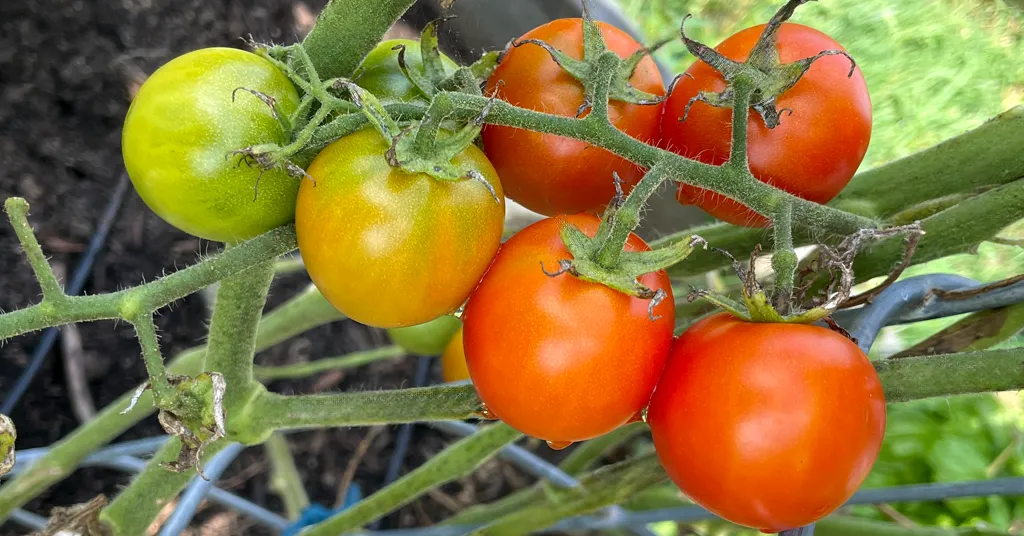
Benefits of Pickled Cherry Tomatoes
Preserving cherry tomatoes through pickling is a fantastic way to extend their shelf life while maintaining their freshness and flavor. Additionally, the pickling process enhances the nutritional profile of tomatoes, making them a healthy addition to your diet.
Ingredients Required for Pickled Cherry Tomatoes
This canning recipe yields about 4 pint jars of pickled cherry tomatoes. This recipe comes from the Ball Blue Book Guide to Preserving 38th Edition on page 95. For this recipe you will need the following ingredients:
- 2 quarts Cherry Tomatoes (you can also use grape tomatoes in this recipe)
- 1 tsp Ball Salt for Pickling and Preserving (or any other pickling salt)
- 1 cup White Wine Vinegar (5% acidity)
- 1 cup White Vinegar (5% acidity)
- 1 quart Water
- 4 cloves of Garlic
- 4 sprigs of Fresh Rosemary
- Ball Pickle Crisp (optional)
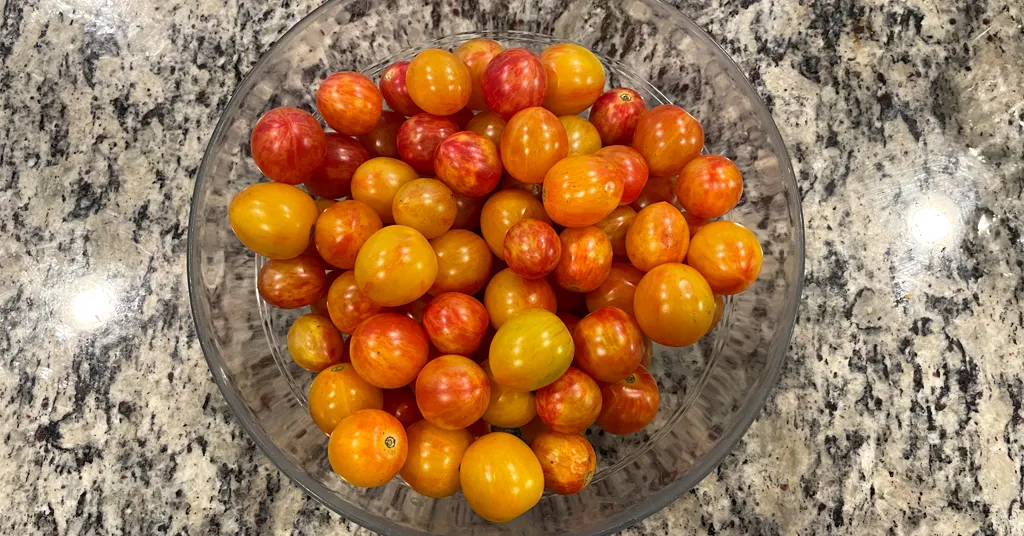
Step-by-Step Pickling and Canning Instructions
Clean Jars
Clean jars and lids with warm soapy water. Ensure the jars do not have any chips or bubbles in the glass.
Prepare Ingredients
Wash tomatoes under cold running water and drain. Prick each tomato with a thin metal skewer to help prevent the peels from bursting open when processing. Pricking tomatoes will not prevent the peels from cracking.
Peel Garlic.
Prepare Canner
Water Bath Canner
Put your water bath canner on your stove. Add your canning rack to the water bath canner. Add your pint jars to the water bath canner. They will warm as you heat the water. Add enough water to cover jars with at least 2-3 inches of water. Start to bring your water to a boil.
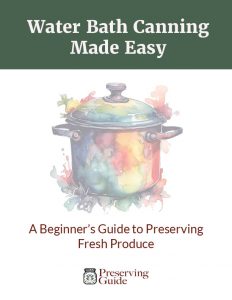
Water Bath Canning Made Easy
Preserve the flavors of your favorite fruits and vegetables with my FREE comprehensive and beginner-friendly Water Bath canning eBook.
Steam Canner
Put your steam canner on your stove. Add the steam canner rack to the bottom of the steam canner. Add the recommended amount of water to the steam canner according to the manufacturer. Add your pint jars to the steam canner. Put the lid on your steam canner and start your stove. The jars will warm as you heat your steam canner.
Prepare Pickling Brine for Pickled Cherry Tomatoes
Combine salt, white wine vinegar, white vinegar, and water in a large pot. Bring mixture to a boil. Reduce heat to a simmer (180°F). Simmer for 10 minutes.
Fill Jars
Once you have hot jars and hot pickling brine
Water Bath Canner
Remove your jars from the water bath canner one at a time using your jar lifter. Dump the water out of the jar into your water bath canner to ensure there is still 2-3 inches of water above your jars.
Steam Canner
Remove the steam canner lid and remove your jars one at a time using your jar lifter.
Pack cherry tomatoes into a hot jar, leaving 1/2 inch (1 cm) headspace. Add 1 clove of garlic and one sprig of fresh rosemary to the pint jar.
Add 1/8 tsp Ball Pickle Crisp to the pint jar, if desired.
Ladle hot pickling brine over the cherry tomatoes, leaving 1/2 inch (1 cm) headspace. Use your headspace measurer to verify space. Remove any air bubbles with your de-bubbler and adjust the headspace, if necessary, by adding more pickling brine.
Wipe the rim of the jar to ensure a good seal is made with the lid. Center the lid on the jar and add the band to fingertip tight. Put the jar back into the canner using your jar lifter.
Repeat until all jars are filled.
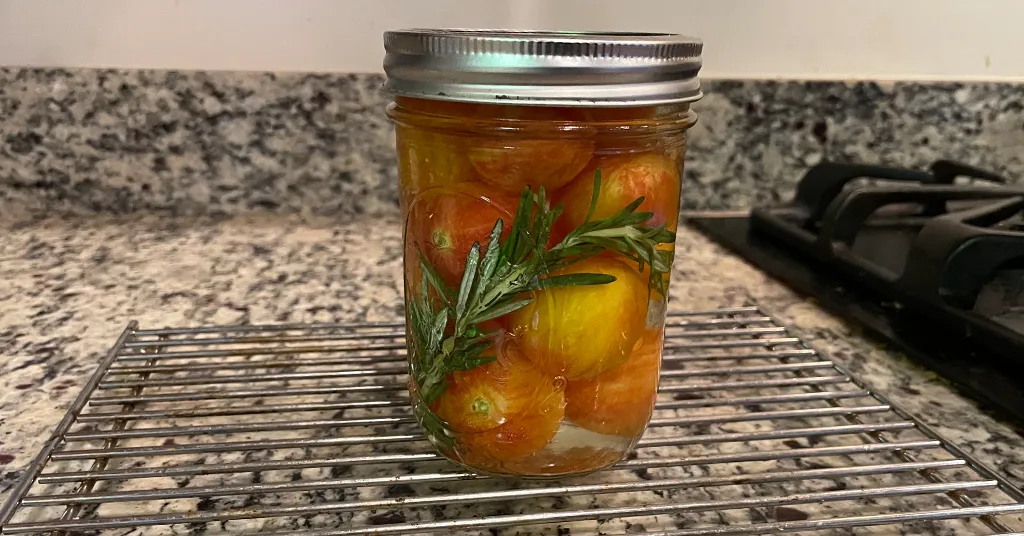
Processing Instructions
Water Bath Canner
Lower the water bath canner rack into the boiling water. Ensure your jars are covered by at least 2 inches of water.
If your water is not boiling start your processing time when the water is boiling. Process pint jars for 10 minutes. Make sure to adjust your time for altitude.
Set a timer, it makes it much easier to make sure you process for the correct time. When your timer goes off turn off the heat and remove the canner lid.
Leave the jars in the water for 5 minutes.
Steam Canner
Put the lid on the steam canner. Turn your stove on high until your steam canner water comes to a vigorous boil. Continue heating so the indicator is in the correct “Zone” per your altitude.
Start your processing time when the needle reaches the maximum point you have tested your steam canner to reach in your “Zone”.
Adjust the burner so that it maintains an even rolling boil throughout the entire processing time. Usually, this will be much lower than where it was set for the vigorous boil. If the top lid is lifting and/or spitting water from the edges this is an indication that you have the heat turned up too high. Slowly reduce the heat until this stops. Watch the indicator to ensure the temperature does not decrease.
The processing times for steam canning are the same as for water bath canning. Process pint jars for 10 minutes.
Make sure to adjust your time for altitude. Set a timer, it makes it much easier to make sure you process for the correct time.
When your timer goes off turn off the heat and let the canner stand for 5 minutes with the lid on before removing the jars. The lid MUST remain ON the canner during this time. This cool-down period is necessary to ensure the jar contents are properly processed.
Carefully remove the lid by tilting it away from you to avoid steam burns.
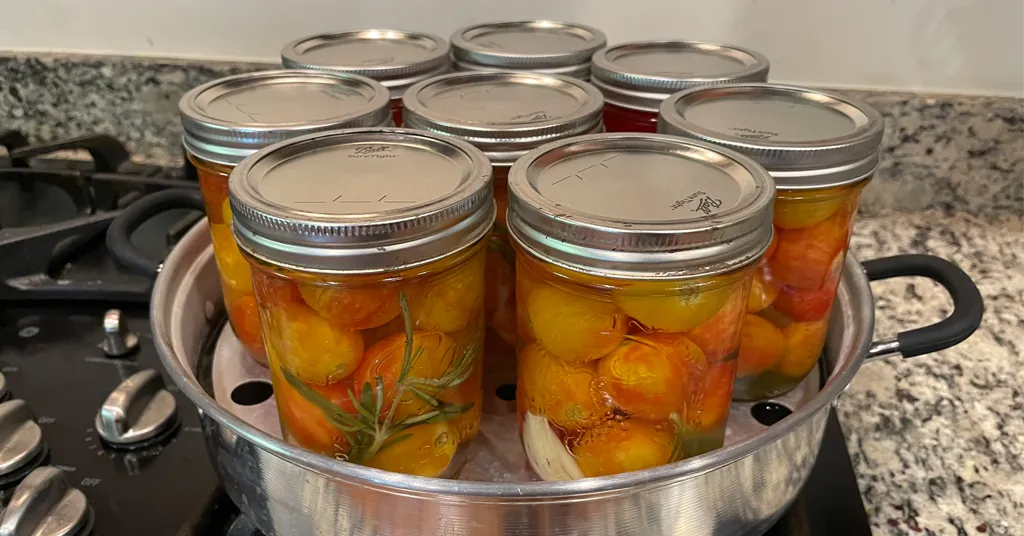
Cool and Store
Using your jar lifer carefully move the jars onto a wire rack or kitchen towel to allow them to cool. When moving the jars try not to tilt them to the side as this could affect the seal of the jars. Allow your jars to cool for 12-24 hours before handling.
Once cool, remove the canning rings from the jars. Wash your jars off to ensure no food residue is on the outside of the jar from processing. Label your jar with the name of the recipe and date. This will help you remember what recipe you used to can and the date will allow you to use the oldest canned goods first.
Creative Serving Ideas
Elevate your culinary creations by incorporating pickled cherry tomatoes into salads or pairing them with cheeses and charcuterie. The burst of flavors adds a gourmet touch to your dishes.
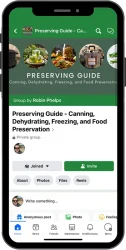
Join My Preserving Guide Facebook Group
Expert tips, tested recipes, and vibrant discussions on canning, dehydrating, freezing, and all things food preservation!
Homemade Pickled Cherry Tomato Gifts
Transform your pickled cherry tomatoes into thoughtful gifts by using creative packaging ideas and adding personalized labels or tags. Share the joy of homemade pickles with your loved ones.
FAQs for Pickled Cherry Tomatoes
Can I use any type of cherry or grape tomatoes for this pickling recipe?
Yes, you can use various types of cherry tomatoes based on your preference. A safe substitute in this recipe is to swap the cherry tomatoes for grape tomatoes.
How long do pickled cherry tomatoes last?
Properly canned and stored, pickled cherry tomatoes can last for several months to years. Make sure to only follow safe and tested canning recipes.
What are some creative ways to use pickled cherry tomatoes?
Try adding them to salads, sandwiches, or as a flavorful topping for appetizers.
More Pickling Recipes
More Recipes for Cherry Tomatoes
Recipe Card
Pickled Cherry Tomatoes
Equipment
- Metal Skewer
- Water Bath Canner or steam canner
- Steam Canner or water bath canner
Ingredients
- 2 quarts Cherry Tomatoes You can substitute grape tomatoes in this recipe
- 1 tsp Pickling Salt
- 1 cup White Wine Vinegar 5% acidity
- 1 cup White Vinegar 5% acidity
- 1 quart water
- 4 cloves garlic peeled, left whole
- 4 sprigs fresh rosemary
- Ball Pickle Crisp Granules Optional
Want to Save this Recipe?
Instructions
- Clean jars and lids with warm soapy water. Ensure the jars do not have any chips or bubbles in the glass.
- Wash tomatoes under cold running water and drain. Prick each tomato with a thin metal skewer to help prevent the peels from bursting open when processing. Pricking tomatoes will not prevent the peels from cracking.
- Peel Garlic
- Prepare your cannerUsing Water Bath Canner: Put your water bath canner on your stove. Add your canning rack to the water bath canner. Add your pint jars to the water bath canner. They will warm as you heat the water. Add enough water to cover jars with at least 2-3 inches of water. Start to bring your water to a boil.Using a Steam Canner: Put your steam canner on your stove. Add the steam canner rack to the bottom of the steam canner. Add the recommended amount of water to the steam canner according to the manufacturer. Add your pint jars to the steam canner. Put the lid on your steam canner and start your stove. The jars will warm as you heat your steam canner.
- Combine salt, white wine vinegar, white vinegar, and water in a large pot. Bring mixture to a boil. Reduce heat to a simmer (180°F). Simmer for 10 minutes.
- Once you have hot jars and hot pickling brine Water Bath Canner:Remove your jars from the water bath canner one at a time using your jar lifter. Dump the water out of the jar into your water bath canner to ensure there is still 2-3 inches of water above your jars.Steam Canner:Remove the steam canner lid and remove your jars one at a time using your jar lifter.
- Pack cherry tomatoes into a hot jar, leaving 1/2 inch (1 cm) headspace. Add 1 clove of garlic and one sprig of fresh rosemary to the pint jar.
- Add 1/8 tsp Ball Pickle Crisp to the pint jar, if desired.
- Ladle hot pickling brine over the cherry tomatoes, leaving 1/2 inch (1 cm) headspace. Use your headspace measurer to verify space. Remove any air bubbles with your de-bubbler and adjust the headspace, if necessary, by adding more pickling brine.
- Wipe the rim of the jar to ensure a good seal is made with the lid. Center the lid on the jar and add the band to fingertip tight. Put the jar back into the canner using your jar lifter.
- Repeat until all jars are filled.
- ProcessingWater Bath Canner:Lower the water bath canner rack into the boiling water. Ensure your jars are covered by at least 2 inches of water.If your water is not boiling start your processing time when the water is boiling. Process pint jars for 10 minutes. Make sure to adjust your time for altitude.Set a timer, it makes it much easier to make sure you process for the correct time. When your timer goes off turn off the heat and remove the canner lid.Leave the jars in the water for 5 minutes.Steam Canner:Put the lid on the steam canner. Turn your stove on high until your steam canner water comes to a vigorous boil. Continue heating so the indicator is in the correct "Zone" per your altitude. Start your processing time when the needle reaches the maximum point you have tested your steam canner to reach in your "Zone".Adjust the burner so that it maintains an even rolling boil throughout the entire processing time. Usually, this will be much lower than where it was set for the vigorous boil. If the top lid is lifting and/or spitting water from the edges this is an indication that you have the heat turned up too high. Slowly reduce the heat until this stops. Watch the indicator to ensure the temperature does not decrease.The processing times for steam canning are the same as for water bath canning. Process pint jars for 10 minutes.Make sure to adjust your time for altitude. Set a timer, it makes it much easier to make sure you process for the correct time.When your timer goes off turn off the heat and let the canner stand for 5 minutes with the lid on before removing the jars. The lid MUST remain ON the canner during this time. This cool-down period is necessary to ensure the jar contents are properly processed.Carefully remove the lid by tilting it away from you to avoid steam burns.
- Using your jar lifer carefully move the jars onto a wire rack or kitchen towel to allow them to cool. When moving the jars try not to tilt them to the side as this could affect the seal of the jars. Allow your jars to cool for 12-24 hours before handling.
- Once cool, remove the canning rings from the jars. Wash your jars off to ensure no food residue is on the outside of the jar from processing. Label your jar with the name of the recipe and date. This will help you remember what recipe you used to can and the date will allow you to use the oldest canned goods first.
Notes
Editorial Process
At Preserving Guide, I take pride in my thorough and impartial approach to recipe and product reviews. Read my editorial process for detailsRobin
Robin Phelps has been preserving food for her family for over 20 years. Today, Robin is a full-time home preservation blogger and coach. Join Robin to learn how to easily make delicious and safe homemade preserved items.
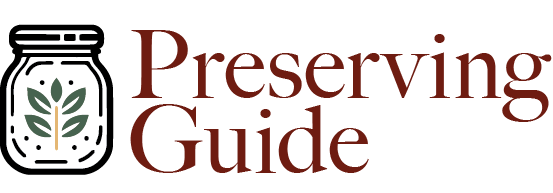
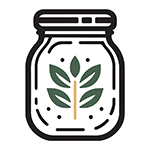
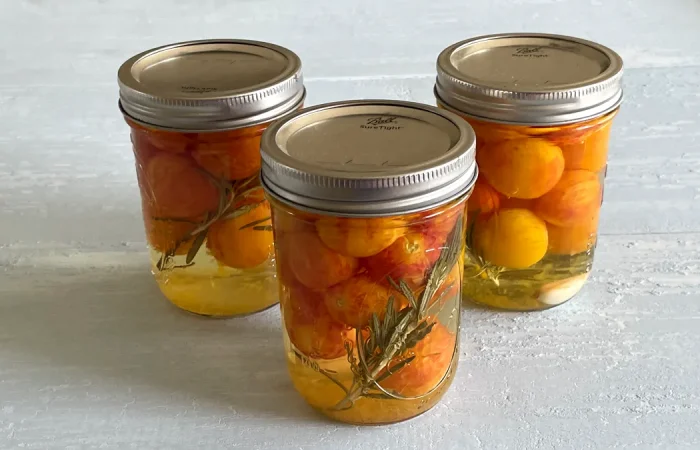
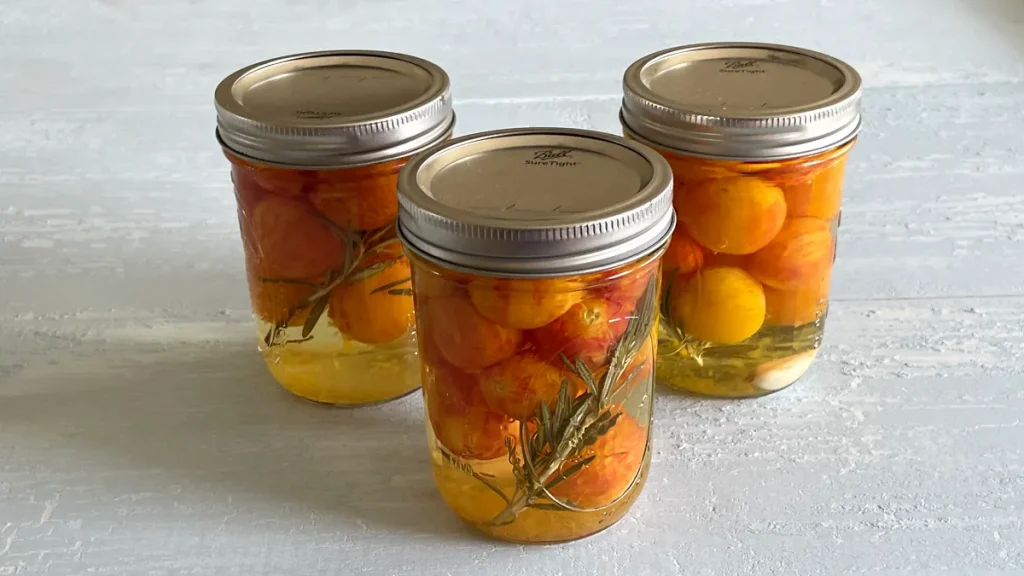
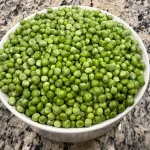
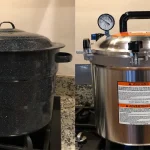
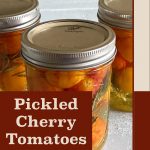
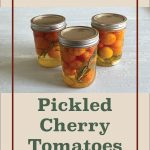
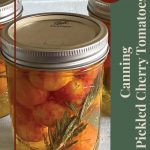
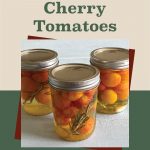
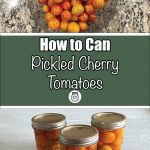
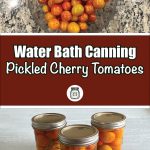
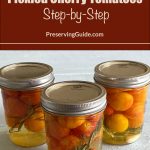

No Comment! Be the first one.